| Columns Retired Columns & Blogs |
...I've got one of them too.
I used DRA Labs' MLSSA system and a calibrated DPA 4006 microphone to measure the Klipsch Reference Premiere RP-600M's frequency response in the farfield, and an Earthworks QTC-40 mike for the nearfield responses. I left the grille off for the measurements, The Klipsch's specified sensitivity is an extraordinarily high 96dB/2.83V/m. My estimate was much lower, at 89.6dB(B)/2.83V/m, though this is still higher than is typical for a small two-way speaker. Fig.1 shows that the RP-600M's impedance magnitude (solid trace) remains above 10 ohms for the entire treble, which means that in this region at least, the Klipsch is very efficient, the speaker drawing significantly less current from the partnering amplifier than would a nominal 8 ohm design. The impedance is lower in the midrange and bass, with a minimum value of 3.5 ohms between 180 and 220Hz. There is also a current-hungry combination of 5.3 ohms magnitude and –42° electrical phase angle (dotted trace) at 128Hz, which suggests that the RP-600M will work best with tube amplifiers when driven from their 4 ohm output-transformer taps.
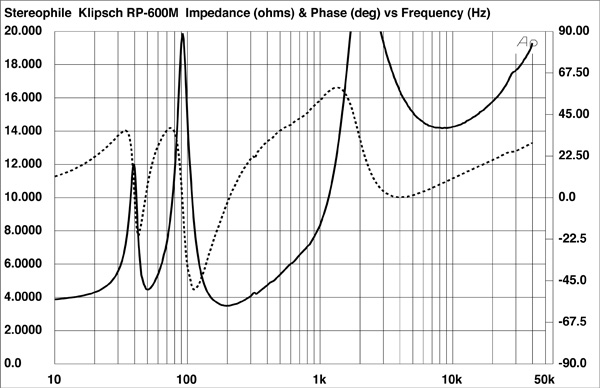
A small discontinuity just above 300Hz in the impedance-magnitude trace suggests some sort of resonance in that region. When I investigated the enclosure's vibrational behavior with a plastic-tape accelerometer, I found on all panels a strong, high-Q mode at 316Hz and a lower-level one at 422Hz (fig.2). These are low enough in frequency and high enough in level that I would have thought they would lead to some midrange congestion. It's fair to note, however, that HR didn't comment on any problems in this region, perhaps because of his use of Blu-Tack to resistively couple the speakers to the stands (footnote 1).
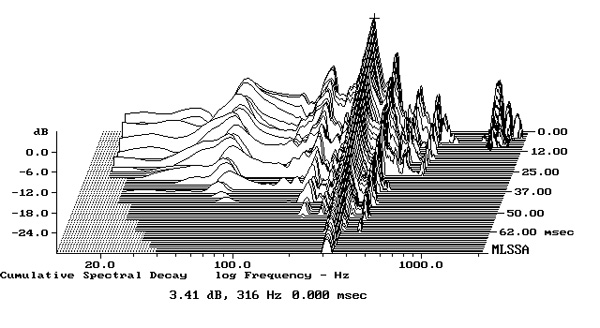
The impedance-magnitude plot has a saddle centered on 48Hz, which implies that this is the tuning frequency of the flared port on the RP-600's rear panel. The blue trace in fig.3 shows the woofer's nearfield response, including a minimum-motion notch at this frequency (ie, when the back pressure from the port resonance holds the cone stationary). The port's nearfield response (red trace) peaks slightly lower in frequency, and its upper-frequency rolloff is disturbed by a peak at 700Hz. As this resonance is low in level and the port fires to the rear, it will probably be inaudible. The woofer is crossed over to the tweeter (green trace) close to the specified 1.8kHz with what appear to be symmetrical, fourth-order acoustic slopes. Both drive-units are relatively flat in their passbands, but this graph suggests that the tweeter is a couple of dB higher in level than the woofer.
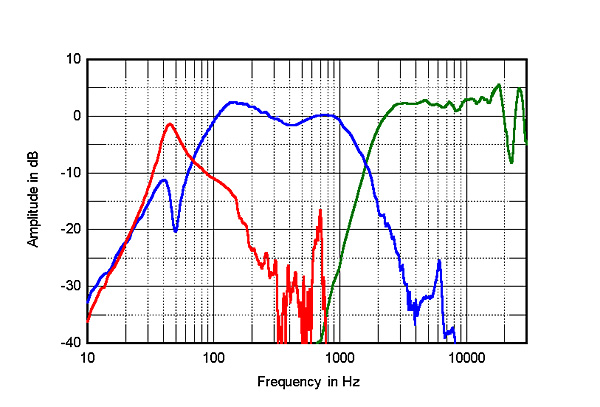
The trace above 300Hz in fig.4 shows the Klipsch's farfield response averaged across a 30° horizontal window centered on the tweeter axis, while below 300Hz it shows the sum of the nearfield woofer and port outputs, taking into account acoustic phase and the different distance of each radiator from a nominal farfield microphone position. The rise in response in the upper bass is an artifact of the nearfield measurement technique. However, it does look as if the port doesn't fully extend the SP-600M's low-frequency output. As HR found, the distance of the speaker from the wall behind it needs to be carefully arranged to balance soundstage precision against bass weight.
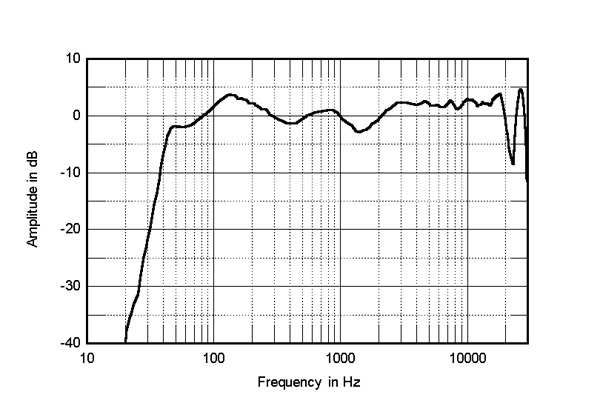
The Klipsch's farfield response has a slight lack of energy in the crossover region. Despite the spatial averaging, the tweeter is still balanced a little too high in level. I wasn't surprised, therefore, that HR found that the RP-600Ms "slightly emphasized the leading edges of notes." HR also wrote that he had "a slight preference" for the sound of the RP-600Ms with their grilles on. The grille reduces the tweeter's output by 1dB or so between 3 and 8kHz.
The Klipsch's horizontal dispersion (fig.5) is characterized by an even and well-controlled rolloff in the treble to the speaker's sides as the frequency increases. This usually correlates with precise stereo imaging, though HR noted a "moderate lack of soundstage width." Above 13kHz, however, the horn-loaded tweeter becomes very directional, which might make the speaker sound a little lacking in top-octave air in large or overdamped rooms. In the vertical plane (fig.6), a suckout develops in the crossover region 10° above and 20° below the tweeter axis.
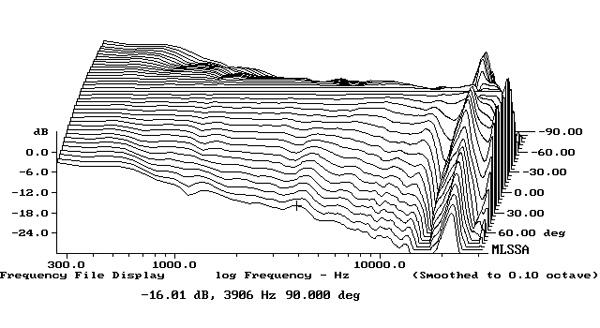
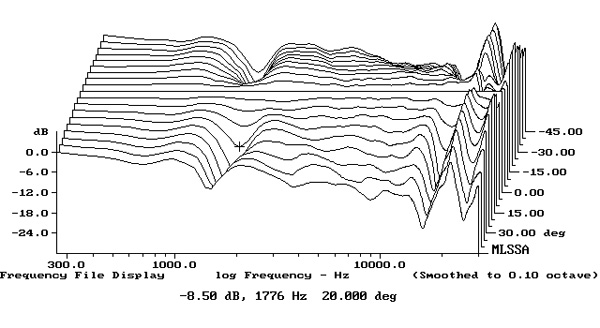
In the time domain, the RP-600M's step response (fig.7) indicates that both drive-units are connected in positive acoustic polarity. The tweeter's step has begun to decay before the woofer's step begins, which suggests that the best blend between the units occurs just below the tweeter axis. The Klipsch's cumulative spectral-decay plot (fig.8) is superbly clean.
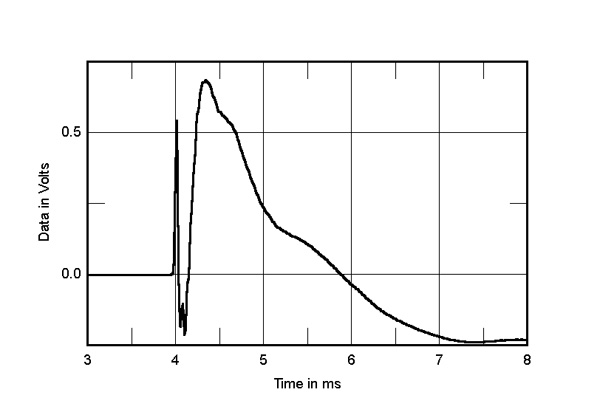
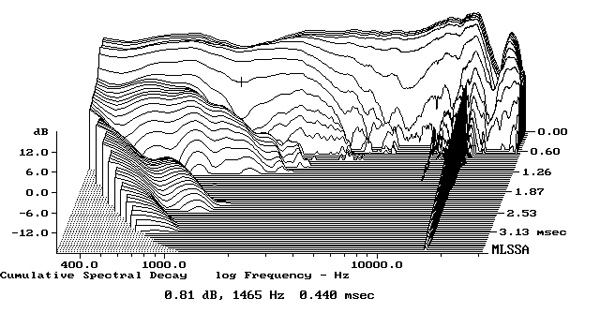
Overall, and that lively enclosure aside, the Klipsch Reference Premiere RP-600M offers impressive measured performance, especially when its affordable price is taken into account.—John Atkinson

...I've got one of them too.

Did you spend your money on another speaker and now you jealous?

... does JA1 give any consideration to using the same (type) of amplifier(s) as used by the reviewer that made the sonic assessment?
It would be interesting to see if there was a significant difference in frequency response when the speaker was driven by the tube-type EleKit TU-8600R as compared to when it was driven by the solid-state First Watt SIT-3.

The review tracks to my own listening, almost went with RP-600M but wanted to try the LS50 as my last listening room set were Klipsch. I really enjoy the LS50 too. When I first tried Klipsch's bookshelves way back when (62i or something), the seller told me they'd be 12db louder at my seating position given same amp level. I did an A/B with sound pressure meter and he was off by 1db. Its crazy how little power Klipsch's need. I'm thinking about a PowerNode 2i and RP-600M for the bedroom, probably be all one needs in a small room.

Match these loudspeakers with either Rogue Audio Cronus Magnum III ($3,000) tube integrated or, Parasound HINT-6 ($3,000) transistor integrated :-) .........

I'm wondering if these loudspeakers make Herb's superb electronics sound
1) superb,
2) better than they usually sound
3) less than they usually sound.
I think I'm reading Mr. HR is say'n their performance is commensurate with his system making them an Audiophile Bargain.
These things are Chinese, dammit.
I called the Klipsch Factory in Hope, they answered the Phone !
Can I call the Klipsch Factory in Mainland China ?
There are 2 Klipsch Factories, one makes throwaway loudspeakers , one makes Legacy Hardwood Loudspeakers.
The Klipsch technology is Scaleable.
Now, can we finally have Wilson Loudspeakers made in China ( for 10% of their USA price ? ) It will only take a little reverse engineereing and Poof, you have it : Cardboard Wilsons ! ( engineered material Wilsons )
Tony in Michigan
ps. Oh Hell, while we're at it, lets make all our pricy gear in China. dcs China gear, Audio Research China, VPI Turntables from China.
and
lets sell China all our dirty Coal to burn

Two words in this article sum up my usual impression of Klipsch, "glared" and "hardness".

As someone who's slagged Stereophile for constantly reviewing products that are well beyond the means of a typical household, it's great to see a very positive review of a speaker that the average household can certainly afford. Bravo! I encourage you to devote page count to one (or more) products like this in each issue. I expect that some audio snobs and Klipsch haters will make sure to tell you how wrong you are in the comments which, to my way of thinking, is a clear indication you're providing stimulus EXACTLY where its needed most.

Except all we know is that the reviewer liked them when used with equipment the typical buyer would never come close to using with these speakers.

"What other speaker manufacturer has continuously manufactured the same flagship model for 73 years? What other speaker maker has three anechoic chambers, one engineered specifically for measuring the compression drivers of horns? What other speaker maker would sell a "Reference Premiere" model for only $549/pair?"
The above has absolutely no business being in a legitimate review. It reads like the spiel of a bad salesman. "Reference Premier" indeed, it is just as easy to put that moniker on a product as "The best we could do for the money". Are we to start evaluating speakers by how many anechoic chambers the manufacturer has.
If this is an example of the kind of blatant favoritism JA is now willing to accept, I am no longer saddened by his departure as Editor in Chief.


https://www.audiosciencereview.com/forum/index.php?threads/klipsch-rp-600m-speaker-review.12138/
Edit: Oops, sorry, someone else posted this. In any case, it’s an honest, unbiased review, and consistent with what most discerning listeners will experience with these loudspeakers.

Audio Science Reviews shows you what a sound measuring robot would experience from a speaker. I think it's neat info but even his subjective reviews are from him listing to a single speaker. The last thing I think about when listing to music is raw data.

I'm not a fan of these speakers, as I find them too recessed in the mids and too hot on top. However, that being said, ASR's measurements show a big 5db dip between 1 and 3khz, while John's show a much smaller 2db dip between 1 and 2 khz. Who do you trust, a rich guy who bought a Klippel system and now thinks he's the world's premier loudspeaker expert (who's only been measuring speakers since 2020), or John, who's been doing this for decades? I know my answer.
In spite of that, I urge anyone interested in this speaker to audition the RP500M, which not only costs less, but is a much better design that is far more balanced and better sounding without the big midrange dip and overly shrill treble of the 600.

Really love his writings and reviews! Thank you

My ears bled. From the first note. OMG!
‘’Their gonna need a good couple hundred hours to break in,’’ said the Klipschophiles.
Not in this house. So, for two years they’ve been gathering dust.
A couple others have come and gone. Real HARD room. No treatment possible right now in this shared space.
Enter the LXminis. INSTANT sweetness! Without having to break anything in…or out. Even SWMBO fell in love with them. Of course, the downside of that is now I've got to share listening time. :(
Thought about using the 600Ms for firewood, but the walls are so thin they wouldn’t even make good kindling. If you own them don't EVER look inside!